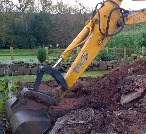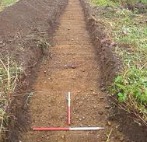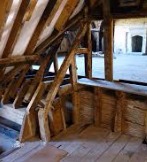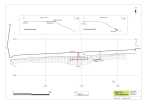
Archaeological Services
We are here to help clear any Archaeological Planning Conditions. Below are the main techniques which may be required on your project:
Desk-based Assessments
A desk-based assessment might be required as a first stage in the process of site evaluation. It involves the collation of existing information relating to a particular site. This allows an assessment of archaeological potential and provides guidance on the likely effectiveness of other types of evaluation such as trial trenching or geophysical survey.
Geophysical Survey
The Contour team have enjoyed great success in reducing costs for commercial developers. Geophysics is usually one of the first step in archaeological fieldwork. We use it to create maps of underground features. Where little of interest is discovered, these maps can be used as evidence to inform planning authorities and to reduce the requirement for further archaeological work. Where the geophysics does detect archaeological features, it allows us to characterise the remains so further works can be more accurately targeted and budgeted. This often results in less fieldwork and therefore reduced costs for you.
Geophysical surveys can also be very useful for research groups and enthusiasts. It is often difficult to get permission to dig known sites like ruined abbeys and castles due to the potential damage that might be caused to the remains, but geophysics offers a safe, non-intrusive means of investigation. Where permission to dig has been granted, these will typically be limited very small trenches and geophysics can help target the dig to parts of the site likely to yield the most information.
Trial Trench Evaluation
Trial trench evaluations provide direct information on the type of remains which might be encountered on a particular site.
Schemes of trial trenching usually commence with the machine excavation (commonly within linear trenches) of topsoil/ploughsoil and any other material regarded as overburden. Any significant remains (pits, ditches, postholes etc.) exposed in the trench will be investigated by hand excavation and recorded.
Historic Building Recording
Proposed alterations to an historic building or buildings may prompt a requirement from a local planning authority, for a programme of Historic Building Recording. The application of archaeological methods to the study of historic buildings can reveal significant evidence relating to past use and development over time.
Excavation
Whilst we will work with you to reduce or remove any requirements for archaeological works, where significant archaeological remains have been identified by evaluation there may be a requirement to undertake mitigation by excavation. This will consist of the removal of topsoil and subsoil, exposing any archaeological features. Based on the agreed strategy these features will be sectioned and recorded clearing the area of any further archaeological work.
Topographic Surveys
used to identify and map the contours of the ground and existing features on the surface of the earth or slightly above or below the earth's surface (i.e. trees, buildings, streets, walkways, manholes, utility poles, retaining walls, etc.). Such a survey can serve as a base map for the design of a residence or building of some type, or design a road or driveway.
Within archaeology, topographic surveys measure and plot earthworks, such as banks, ditches, mounds and areas of ridge and furrow cultivation, to create a plan of what exists on the ground.







